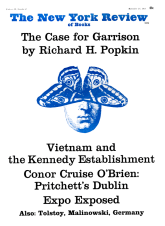In response to:
The Poe Mystery Case from the July 13, 1967 issue
To the Editors:
Given Richard Wilbur’s intricate and ingenious reading of “The Murders in the Rue Morgue” [NYR, July 13], I am puzzled that he should be puzzled by so unsubtle a poem as “The Haunted Palace.” “We must go to Poe’s letters,” he writes, “for his admission that the ‘Haunted Palace’ represents ‘a mind haunted by phantoms.’ ” Where are the new critics of yesteryear? I should have thought even a cursory inspection of the key lines would show how blatant and obvious Poe’s symbolism is:
Once a fair and stately palace—Radiant palace—reared its head.
Banners yellow, glorious, golden, On its roof did float and flow…
Wanderers in that happy valley, Through two luminous windows, saw
Spirits moving musically…And all with pearl and ruby glowing Was the fair palace door,
Through which came flowing, flow- ing, flowing A troop of Echoes…
Surely, there needs no ghost come from Poe’s letters to tell us he is describing a blond head—particularly since the symbolism is quite traditional in our culture: Ecclesiastes, no less than “The Haunted Palace,” points to a time when “the keepers of the house shall tremble, and the strong men shall bow themselves, and the grinders cease because they are few, and those that look out of the windows be darkened.”
Norman N. Holland
State University of New York
Buffalo, N.Y.
Richard Wilbur replies:
Mr. Holland refers to a paragraph in which I was illustrating Poe’s occasional willingness to be explicit about his major symbols—to tell us what they mean, as in the phrase “the grey ruins of memory.” In the sentence partially quoted by Mr. Holland, I was trying to say only this: that while we must go to Poe’s letters for a frank explanation of the architectural symbolism of “The Haunted Palace,” there are other symbolic works, such as “Berenice,” which here and there frankly explain themselves.
I did not, in any case, mean to say that some letter of Poe’s is essential to an understanding of “The Haunted Palace.” I share Mr. Holland’s opinion that “The Haunted Palace” is conspicuously allegorical, and that the poem, though it “explains itself” very little, is easily decoded. As I have said more than once in print, what we have is a description of a head formerly equipped with fair hair, bright eyes, red lips, white teeth, and melodious voice; within the now unhandsome head is a mind which has passed from mastery to confusion.
Mr. Holland’s mention of the Ecclesiastes passage as a precedent for Poe’s building-symbolism seems to me very just.
This Issue
September 14, 1967



